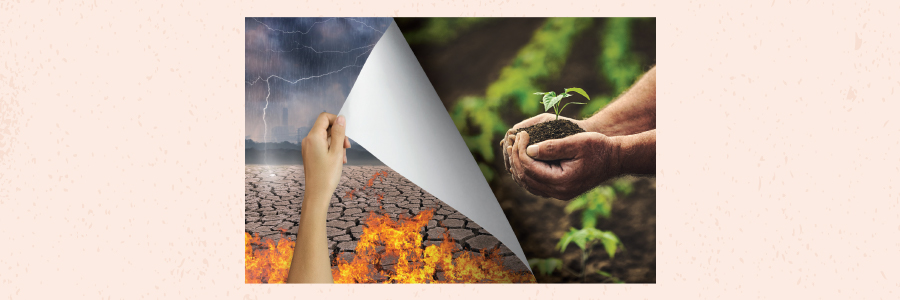


Sign-up for {N}power to get exclusive discounts, newsletters, members-only features, and more!
 Denver - Design District - Alameda and Broadway
Denver - Design District - Alameda and Broadway
368 S Broadway
Denver, CO 80209
United States
 Preferred Store:
Select a Store
Preferred Store:
Select a Store

As the apocalyptic red skies of fire season and the extremes of drought and flooding become increasingly commonplace, life as we know it is being threatened, and one industry in which we are seeing the real-time effects is agriculture. Our farmlands are extremely vulnerable to these severe effects of climate change, putting our food supply at risk.1 But there is a solution, and it starts from the ground up—organic and regenerative agricultural practices are proven to help mitigate the impact of devastating natural disasters driven by climate change.2
Research shows that conventional industrial agriculture is a major contributor to climate change, from greenhouse gas emissions to soil degradation. According to the Food and Agriculture Organization of the United Nations, agriculture and related land use released 9.3 billion tons of carbon dioxide (CO2) into our atmosphere in 2018.3 (This makes agriculture one of the world’s top sources of greenhouse gasses, just below transportation and energy production.) The emissions occur from processes such as tilling, which releases CO2 stored in the earth, and synthetic fertilizer use.
The practices of tilling, mono-cropping, pesticides, and synthetic fertilizers used by conventional industrial farms deplete and break down the structure of the soil, preventing it from capturing and storing CO2, while also reducing its permeability and water-holding capacity, which is integral to its resilience. For soil to efficiently absorb water it must be porous and made up of a multitude of compounds of different sizes—this includes things such as microbes, invertebrates like earthworms, and fungi.4

During the rainy season, because conventional farming methods make the soil less permeable, conventionally farmed land is at a high risk of flooding. To compound these problems, when flooding occurs, the runoff from non-organic farms filled with toxic pesticides and fertilizers makes its way into our water systems. Atrazine, a common herbicide in conventional farming, encourages algal overgrowth in rivers causing "dead zones" where fish and other water-dwelling species are deprived of oxygen.5 These agricultural chemicals pollute our waterways while the flooded cropland is no longer able to produce at its maximum capacity, if at all.
Conversely, during wildfire season, depleted soil that does not effectively retain rainwater is vulnerable to drought and fires. As of mid-September 2020, wildfires devastated 6.9 million acres across 11 states.6 The damage caused by wildfires to agricultural lands can take years to repair.
But this does not have to be the case. Regenerative, organic farming practices turn dirt into nutrient-rich soil by minimizing or eliminating tilling, abstaining from toxic pesticides, rotating crops, planting cover crops, and adding nutritious organic amendments to the soil such as compost. Healthy soil is filled with a diversity of microorganisms and contains a mixture of particle sizes to create a porousness that holds onto water as needed—and allows the water to be accessed by plants throughout the seasons while preventing excessive runoff.
The water held in the soil also helps the land to be more resistant to wildfires. Organic farmlands, in this way, can help protect surrounding urban areas.8 Effective rainfall sequestered in the soil also allows farms to fair better during extreme weather, such as drought.7 For example, the Rodale Institute's research shows that organic agriculture has "the potential to produce yields up to 40% higher than conventional systems" during drought.9
The simple act of choosing organic foods supports ecosystems that encourage nature to thrive in its natural state of biodiversity, taking care of the planet from the ground up. This September, we invite you to join us in celebrating Organic Month by choosing organic wherever possible, to support not only your own health, but the health of our planet!



Sign-up for {N}power to get exclusive discounts, newsletters, members-only features, and more!
